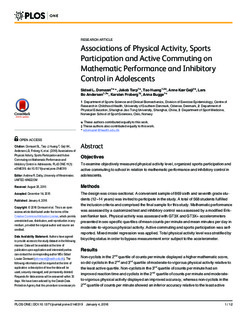| dc.contributor.author | Domazet, Sidsel L. | |
| dc.contributor.author | Tarp, Jakob | |
| dc.contributor.author | Huang, Tao | |
| dc.contributor.author | Gejl, Anne Kær | |
| dc.contributor.author | Andersen, Lars Bo | |
| dc.contributor.author | Froberg, Karsten | |
| dc.contributor.author | Bugge, Anna | |
| dc.date.accessioned | 2017-01-02T12:53:13Z | |
| dc.date.available | 2017-01-02T12:53:13Z | |
| dc.date.issued | 2016-01-04 | |
| dc.identifier.citation | PLoS ONE. 2016. doi: http://dx.doi.org/10.1371/journal.pone.0146319 | nb_NO |
| dc.identifier.uri | http://hdl.handle.net/11250/2425992 | |
| dc.description.abstract | Objectives: To examine objectively measured physical activity level, organized sports participation and active commuting to school in relation to mathematic performance and inhibitory control in adolescents. Methods: The design was cross-sectional. A convenient sample of 869 sixth and seventh grade students (12–14 years) was invited to participate in the study. A total of 568 students fulfilled the inclusion criteria and comprised the final sample for this study. Mathematic performance was assessed by a customized test and inhibitory control was assessed by a modified Eriksen flanker task. Physical activity was assessed with GT3X and GT3X+ accelerometers presented in sex-specific quartiles of mean counts per minute and mean minutes per day in moderate-to-vigorous physical activity. Active commuting and sports participation was self-reported. Mixed model regression was applied. Total physical activity level was stratified by bicycling status in order to bypass measurement error subject to the accelerometer. Results: Non-cyclists in the 2nd quartile of counts per minute displayed a higher mathematic score, so did cyclists in the 2nd and 3rd quartile of moderate-to-vigorous physical activity relative to the least active quartile. Non-cyclists in the 3rd quartile of counts per minute had an improved reaction time and cyclists in the 2nd quartile of counts per minute and moderate-to-vigorous physical activity displayed an improved accuracy, whereas non-cyclists in the 2nd quartile of counts per minute showed an inferior accuracy relative to the least active quartile. Bicycling to school and organized sports participation were positively associated with mathematic performance. Conclusions: Sports participation and bicycling were positively associated with mathematic performance. Results regarding objectively measured physical activity were mixed. Although, no linear nor dose-response relationship was observed there was no indication of a higher activity level impairing the scholastic or cognitive performance. | nb_NO |
| dc.language.iso | eng | nb_NO |
| dc.publisher | PLOS | nb_NO |
| dc.subject | schools | |
| dc.subject | adolescents | |
| dc.subject | exercise | |
| dc.subject | physical activity | |
| dc.subject | reaction time | |
| dc.subject | cognitive psychology | |
| dc.subject | cognition | |
| dc.subject | accelerometers | |
| dc.title | Associations of Physical Activity, Sports Participation and Active Commuting on Mathematic Performance and Inhibitory Control in Adolescents | nb_NO |
| dc.type | Journal article | nb_NO |
| dc.type | Peer reviewed | nb_NO |
| dc.subject.nsi | VDP::Matematikk og Naturvitenskap: 400::Basale biofag: 470 | nb_NO |
| dc.subject.nsi | VDP::Landbruks- og Fiskerifag: 900::Landbruksfag: 910 | nb_NO |
| dc.source.journal | PLoS ONE | nb_NO |
| dc.identifier.doi | http://dx.doi.org/10.1371/journal.pone.0146319 | |
| dc.description.localcode | Seksjon for idrettsmedisinske fag / Department of Sports Medicine | nb_NO |
